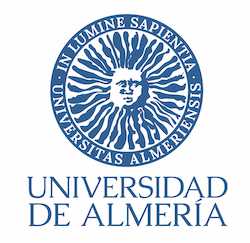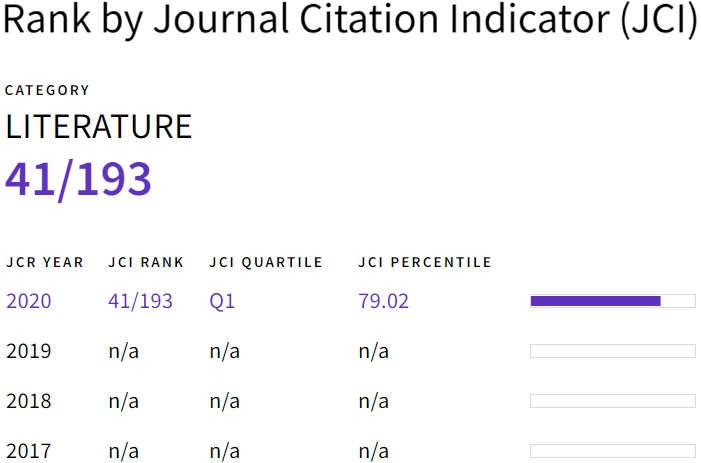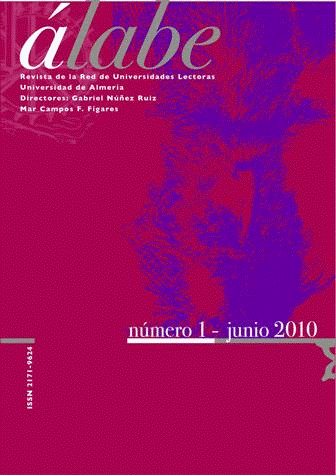Literacia e conectividade intercultural: práticas de leitura para jovens
Resumen
A mundialização económica, a indústria 4.0, a migração (voluntária e forçada) atual de pessoas e a globalização via Internet aproximam os jovens, gerando novos entendimentos e perspetivas que se entrecruzam, se chocam e se desafiam mutuamente, num contexto de ‘superdiversidade’, em que diversas variáveis sociais, étnicas, linguÃsticas e identitárias se intersetam para influenciar trajetórias de vida. Através de estudos de caso múltiplos, o artigo descreve novas formas de participação na leitura ditadas pela conectividade da web 2.0 e 3.0, relevando materiais, abordagens e desenvolvimento de uma literacia cultural para enfrentar o mundo cada vez mais diverso em que vivemos; e, consequentemente, novos conceitos sociais de jovem ‘leitor’. O artigo é escrito com o intuito de alertar os educadores de jovens para novas formas de utilizar a leitura para ler o mundo e atuar nele, dando uma ênfase especial à construção de competências para uma cidadania multicultural crÃtica.Â
Palabras clave
Texto completo:
PDF (Português (Brasil))Referencias
Allan, J., Ellis, S. & Pearson, C. (2005). Literature Circles, Gender and Reading for Enjoyment. Edinburgh: Scottish Executive Education Department.
Bauman, Z. (2003). Liquid Love: On the Frailty of Human Bonds. Oxford: Blackwell.
Bokova, I. (2015). Rethinking Education. Towards a global common good? Paris: Unesco.
Boltz, R. H. (2007). What We Want: Boys and Girls Talk about Reading. School Library Media Research, nr.10. Available online: http://www.ala.org/aasl/sites/ala.org.aasl/files/content/aaslpubsandjournals/slr/vol10/SLMR_WhatWeWant_V10.pdf
Botelho, M. J. & Rudman, M. K. (eds.) (2010). Critical Multicultural Analysis of Children’s Literature. Mirrors, Windows, and Doors. New York: Routledge.
Boys Reading (2015). Research on the State of the Art. Available online: http://boysreading.org/index.php/en/resources/project-outputs/research-reports http://boysreading.org/project-outputs/IO1/O1_A2_Compile_FocusGroupReport.pdf
Boys Reading (2016) Boys' Reading Toolkit. Available online: http://boysreading.org/index.php/en/resources/toolkit
Breidbach, S. (2003) Plurilingualism, Democratic Citizenship in Europe and The Role of English. Strasbourg: Council of Europe.
Byram, M., Gribkova, B. & Starkey, H. (2002). Developing the Intercultural Dimension in Language Teaching. Strasbourg: Council of Europe.
Chance, R., & Lesesne, T. (2012). Rethinking reading promotion: Old school meets technology. Teacher Librarian, nr.39(5),26-28.
Cotton, P. & Daly, D. (2014). Visualising Cultures: The “European Picture Book Collection†Moves “Down Underâ€. Children's Literature in Education. Vol.46, Issue 1,88-106.
Council of Europe (2016). Competences for Democratic Culture. Living Together as Equals in Culturally Diverse Democratic Societies. Strasbourg: Council of Europe. https://rm.coe.int/16806ccc07
Cypress, A., & Lee-Anderson, K. (2011). The impact of boys and literacy: Connecting boys with books, engaging the adolescent reader. International Journal of Interdisciplinary Social Sciences, nr.5(10),59-71.
Comissão Europeia (2012). EU High Level Group of Experts on Literacy. Final Report. Bruxelas: Comissão Europeia.
Eden, S., Shamir, A., & Fershtman, M. (2013). Making a Difference: Using Laptops as a Support for Spelling Improvement Among Students with Learning Disability. In A. Shamir & O. Korat (eds.). Technology as a support for literacy achievements for children at risk (pp. 199-209). Dordrecht: Springer.
European Commision (2008). Education and Migration. Strategies for integrating migrant children in European schools and societies. Available online: http://www.nesse.fr/nesse/activities/reports/activities/reports/education-and-migration-pdf
Farris, P. J., Werderich, D. E., Nelson, P. A., & Fuhler, C. J. (2009). Male call: Fifth-grade boys' reading preferences. Reading Teacher, nr.63 (3),180-188.
Fisher, D., & Frey, N. (2012). Motivating boys to read: Inquiry, modeling, and choice matter. Journal of Adolescent & Adult Literacy, nr.55 (7),587-596.
Forsthuber, B., Horvath, A. & Motiejunaite, A. (2010). Gender differences in educational outcomes: study on the measures taken and the current situation in Europe. Brussels: Education, Audiovisual and Culture Executive Agency, European Commission. Available on: http://bookshop.europa.eu/en/gender-differences-in-educational-outcomes-pbEC3209196/
Gilmore, N, & Burnett, M. (2014). Crunching Numbers at the Nielsen Children’s Book Summit. Publishers Weekly. December 16. Available on: http://www.publishersweekly.com/pw/by-topic/childrens/childrens-industry-news/article/65068-kids-are-thriving-reading-and-hungry-for-more-crunching-numbers-at-the-nielsen-children-s-book-summit.html
Graham, J. (1990). Pictures on the Page. Sheffield: National Association for Teaching English.
Gurian, M. (2010). Boys and girls learn differently! A guide for teachers and parents. San Francisco: John Wiley & Sons.
Gunter, G., & Kenny, R. (2008). Digital booktalk: Digital media for reluctant readers. Contemporary Issues in Technology and Teacher Education, nr.8(1),84-99.
Hilton, M. (1996). Lost Boys? Violence and Imperialism in Popular Constructions of Masculinity. In M. Styles, E. Bearne and V. Watson (eds). Voices Off. Texts, Contexts and Readers. (pp. 291-309). London: Cassell.
Horizon (2014). Horizon Report. Available on: http://files.eric.ed.gov/fulltext/ED559384.pdf
Ito, M. et allii (2010). Hanging Out, Messing Around, and Geeking Out. Kids Living and Learning with New Media. Cambridge, MA: The MIT Press.
Jenkins, R. & Kelly, W. Eds. (2013). Reading in a Participatory Culture. Remixing Moby-Dick in the English Classroom. New York and London: Teachers College Press.
Limbrick, L., Wheldall, K., & Madelaine, A. (2011). Why do more boys than girls have a reading disability? A review of the evidence. Australasian Journal of Special Education, nr.35(01),1-24.
LiRe2.0 (2017). LiRe2.0 Toolkit. Available on: http://lifelongreaders.org/resources/toolkit/english/#116
Love, K., & Hamston, J. (2003). Teenage boys' leisure reading dispositions: Juggling male youth culture and family cultural capital. Educational Review, nr.55(2),161-177.
Merisuo-Storm, T. (2006). Girls and boys like to read and write different texts. Scandinavian Journal of Educational Research, nr.50(2),111-125.
Moss, G. (1989). Un/popular Fictions. London: Virago Press.
National Literacy Trust (2012). Report: Boys’ Reading Commission. London: Literacy Trust.
Ontario Ministry of Education (2004). Me Read? No Way. A Guide to Improving Boys’ Literacy Skills. Available on: www.edu.gov.on.ca/eng/document/brochure/meread/meread.pdf
Ramos, I. (2010). O PNL e as TIC: Efeitos na relação dos alunos com a Leitura. Tese de Dissertação de Mestrado em Multimédia em Educação. Aveiro: Universidade de Aveiro.
Ramos, N. (2013). Interculturalidade(s) e mobilidade(s) no espaço europeu: viver e comunicar entre culturas. In The Overarching Issues of the European Space. (pp. 343-360). Porto: Faculdade de Letras da Universidade do Porto.
Rosnay, J. (2006). La révolte du proletariat. Paris: Fayard.
Rouet, J. (2001). Les Activités Documentaires Complexes – Aspects Cognitifs et Devéloppementaux. Poitiers : Université de Poitiers, 2001.
(Rapport d’Habilitation à Diriger des Recherches). Available on: http://tecfa.unige.ch/tecfa/teaching/uv39/papiers/HA-Rouet2001.pdf.
Rheingold, H. (2012). Net smart. How to thrive online. Cambridge, MA: MIT Press.
Roche, M. (2010). Critical Thinking and Book Talk: Using picture books to promote discussion and critical thinking in the classroom. Reading news (Conference edition). Dublin: Reading Association of Ireland.
Roche, M. (2015). Developing Children’s Critical Thinking through Picture books. A guide for primary and early years students and teachers. Oxon: Routledge.
Schwab, K. (2016) Welcome to the Fourth Industrial Revolution. Rotmann Magazine. Fall 2016,19-24.
Segers, E., & Verhoeven, L.L. (2002). Multimedia support of early literacy learning. Computers & Education, nr.39(3),207–221.
Senn, N. (2012). Effective approaches to motivate and engage reluctant boys in literacy. Reading Teacher, nr.66(3),211-220.
Serafini, F. (2013). Supporting boys as readers. Reading Teacher, nr.67(1),40-42.
Snowball, C. (2005). Teenage reluctant readers and graphic novels. Young Adult Library Services, nr.3(4),43-45.
Tavares, C. & Barbeiro, L. (2008). TIC: implicações e potencialidades para a leitura e escrita. Intercompreensão, nr.14,129-157.
Tavares, C. & Barbeiro, L. (2011). PNEP - As implicações das TIC no Ensino da LÃngua. Lisboa: Ministério da Educação-DGIDC.
UNESCO (2013). Intercultural Competences. Conceptual and Operational Framework. Paris: Unesco. Available on: http://unesdoc.unesco.org/images/0021/002197/219768e.pdf
Unsworth, L. (2001). Teaching Multiliteracies across the Curriculum. Changing contexts of text and image in classroom practice. Buckingham, Philadelphia: Open University Press.
Watson, V. (1996). Innocent Children and Unstable Literature. In M. Styles, E. Bearne and V. Watson (eds.). Voices Off. Texts, Contexts and Readers. (pp. 1-15). London: Cassell.
ΚοκκÎβη Ά, Φωτίου Α, Ξανθάκη Îœ., ÎšÎ±Î½Î±Î²Î¿Ï Î•. (2011). Ο ΕλεÏθεÏος ΧÏόνος των Εφήβων. Πανελλήνια ΈÏευνα στους ΜαθητÎÏ‚ 2011, ΕΠΙΨΗ EÏευνητικό Πανεπιστημιακό ΙνστιτοÏτο Ψυχικής Υγιεινής (Health Behavior in School-Aged Children).
DOI: http://dx.doi.org/10.15645/Alabe2019.19.1


































